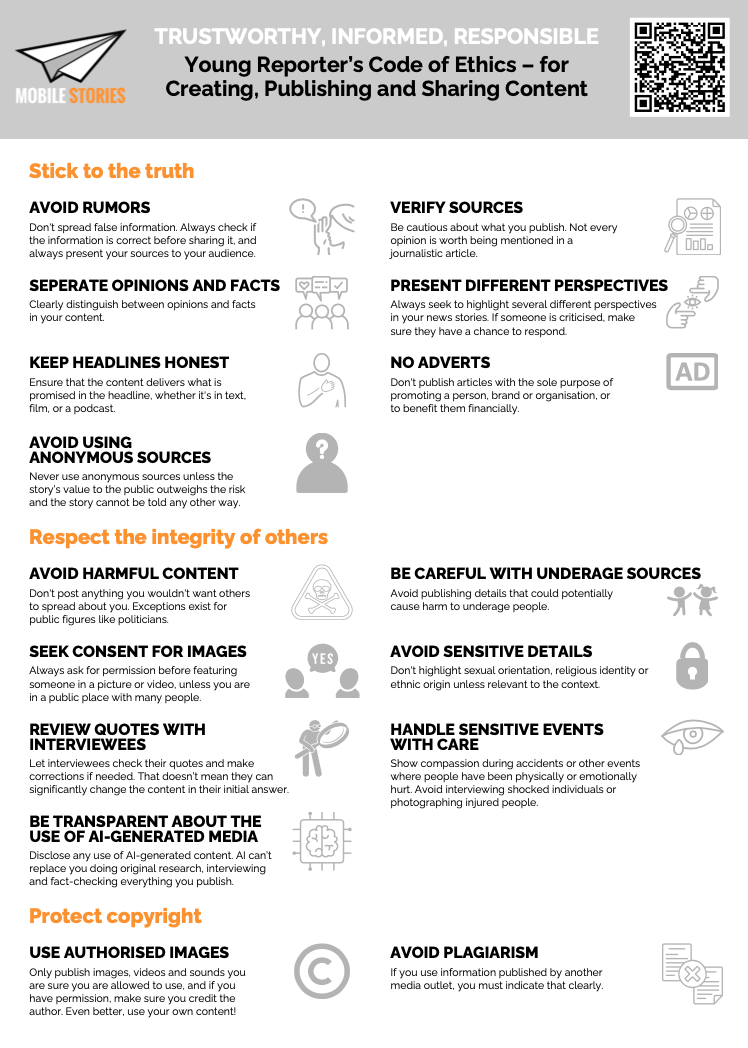TRUSTWORTHY, INFORMED, RESPONSIBLE
Young Reporter´s Code of Ethics
Young Reporter’s Code of Ethics – for Creating, Publishing, and Sharing Content



Click on the image to download the poster.
Stick to the Truth:
Avoid rumors: Don’t spread false information. Always check if the information is correct before sharing it, and always present your sources to your audience.
It is your duty as a journalist to verify all information you publish, even when you quote someone else. Journalists must seek evidence for the things they publish even if the information seems true and interesting at first. Everyone is biased. That is why a journalist cannot go on gut instincts or feelings or intuition – they need proof.
Verify sources: Be cautious about what you publish. Not every opinion is worth being mentioned in a journalistic article.
Evaluate whether the person you are interviewing is well-informed. If you are publishing statistics or research findings from an organisation, you need to research who they are and consider if you can trust them.
Separate opinions and facts: Clearly distinguish between opinions and facts in your content.
Quality media outlets have separate sections for news and opinions. Opinion articles should always be labeled as opinions or comments. Your opinion or opinions of one person do not make a news article. Remember, that factual claims can be proven with evidence like statistics, observations of an event and scientific evidence. Opinions are subjective judgments.
Present different perspectives: Always seek to highlight several different perspectives in your news stories. If someone is criticised, make sure they have a chance to respond.
In news articles, you don’t share your own perspective. Instead, you learn from others and then share what you learned with the public. You have to try to include the opinions of subject matter experts or those who are impacted by the event in question and show what the different sides disagree on. Even in opinion articles, consider discussing the other side’s perspective and explain why you think they are wrong.
Keep headlines honest: Ensure that the content delivers what is promised in the headline, whether it’s in text, film, or a podcast.
You must make sure that your headline is factually true. It also has to match the content of your article. Attracting readers is important, but journalists should value accuracy more.
No adverts: Don’t publish articles with the sole purpose of promoting a person, brand or organisation, or to benefit them financially.
As a journalist, your job is to serve the interests of the general public, not any specific organisation or individual. You can publish stories that paint others in a positive light but your motivation should be to inform and inspire others.
Avoid using anonymous sources. Never use anonymous sources unless the story’s value to the public outweighs the risk and the story cannot be told any other way.
Consider if you might be pressured to reveal who the anonymous person is. If you feel like you wouldn’t be able to protect them, it is best to choose sources who can reveal their name.
Respect the Integrity of Others:
Avoid harmful content: Don’t post anything you wouldn’t want others to spread about you. Exceptions exist for public figures like politicians.
If you want to publish negative information about others, consider how you can justify it. Did their actions have harmful consequences for many people? Curiosity about other people’s private lives is not enough of a justification for an ethical journalist. Also consider the potential harm your article could cause for the underage children of a person that is criticised in your story. However, just because you need to show empathy does not mean you cannot publish bad news and critical stories.
Be extra careful with underage sources. Avoid publishing details that could potentially cause harm to underage people.
Consider if the information you have published could lead to negative consequences in their school, family, city or friendship group. Always remember that young people are more vulnerable and dependent on others than adults.
Seek consent for images: Always ask for permission before featuring someone in a picture or video, unless you are in a public place with many people.
If underage people are featured in your footage, check the relevant policy at your school or organisation. If you are featuring someone under 12, always seek consent from the parent or guardian.
Avoid unnecessary details that can be sensitive: Don’t highlight sexual orientation, religious identity, or ethnic origin unless relevant to the context.
Even if the source mentions something about their identity, consider whether publishing that information might put them in danger or lead to bullying.
Review quotes with interviewees: Let interviewees check their quotes and make corrections if needed. That doesn’t mean they can significantly change the content in their initial answer.
Handle sensitive events with care: Show compassion during accidents or other events where people have been physically or emotionally hurt. Avoid interviewing shocked individuals or photographing injured people.
If you are reporting an accident or an event that was traumatic for someone, respect their choice not to talk about it. Make sure to ask for permission to use their photo or words. Make sure they understand that the information they give you will become public. If someone is hurt, the most important thing is for them to get help. If someone gives you an interview in a stressful situation, consider if they would want you to publish what they said when they are calm.
Be transparent about the use of AI-generated media. Disclose any use of AI-generated content. AI can’t replace you doing original research, interviewing and fact-checking everything you publish.
Protect Copyright:
Use authorised images: Only publish images, videos and sounds you are sure you are allowed to use, and if you have permission, make sure you credit the author. Even better, use your own content!
You cannot take any content you find online and republish it. Make sure you do your research about who is the author and whether they want someone to reuse it. It is always safer to use your own content. You will not have to seek permission and you will be sure you are not using manipulated media.
Avoid plagiarism. If you use information published by another media outlet, you must indicate that clearly.
Remember, it’s important to create content responsibly and with respect for others’ privacy and well-being.

